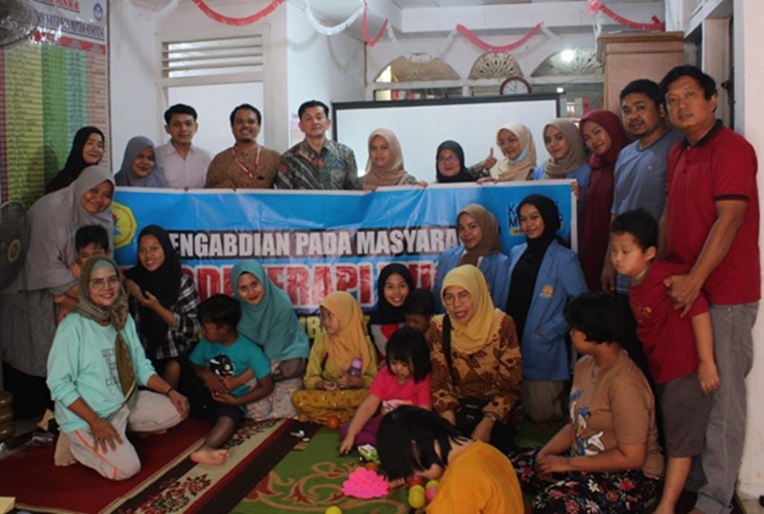Pemberdayaan Orangtua dan Guru dalam Meningkatkan Atensi Anak Autis Spectrume Disorder di Sekolah Autis Mitra Ananda Padang Empowering Parents and Teachers in Increasing the Attention of Children with Autistic Spectrum Disorders at the Mitra Ananda Autism School in Padang
Main Article Content
Abstract
Developmental disorders of joint attention or attention are the main characteristics of children with autism spectrum disorder (ASD). Therefore, it is essential to develop these skills in early intervention efforts. Empowering parents and teachers is essential for success in increasing the attention of children with ASD; parents and teachers play an essential role in programs for treating children with ASD. This service explores techniques for empowering parents and teachers to increase attention to children with ASD. Establishing communication and cooperation between parents and teachers is carried out by the management of the Ananda Padang Autistic Partner School. The methods used in this community service activity include lecture, question and answer, discussion, and practice methods. The aim is to provide education to increase the understanding of parents and teachers in increasing the attention of children with ASD. The activity was carried out from 13 and 14 October 2023 with nine parents and nine teachers. There was an increase in scores on the post-test after clients were given education about increasing attention in children with ASD, namely from an average of 2.78 to 4.80. Parents and teachers also felt satisfied with the activities carried out, with an average score for material quality of 6.05, media of 5.60, and benefits of activities of 5.20. The output of this activity is an increase in the knowledge of parents and teachers after receiving education, namely an increase in the average post-test score. The activity info link can be seen at https://forumsumbar.com/berita/38383/tim-pkm-mercubaktijaya-berdayakanorangtua-and-teachers-in-improving-children's-attention-asd/
Downloads
Article Details

This work is licensed under a Creative Commons Attribution-ShareAlike 4.0 International License.
Authors who publish with this journal agree to the following terms:
- Any article on the copyright is retained by the author(s).
- Author grant the journal, right of first publication with the work simultaneously licensed under a Creative Commons Attribution License that allows others to share work with acknowledgment of the work authors and initial publications in this journal.
- Authors are able to enter into a separate, additional contractual arrangements for non-exclusive distribution of published articles of work (eg, post-institutional repository) or publish it in a book, with acknowledgment of its initial publication in this journal.
- Authors are permitted and encouraged to post their work online (e.g., in institutional repositories or on their websites) prior to and during the submission process, as can lead to productive exchanges, as well as earlier and greater citation of published work.
- The article and any associated published material is distributed under the Creative Commons Attribution-ShareAlike 4.0 International License
References
Acocella, J. Alloy, LB., Bootzin, RR. (2005). Autism. Abnormal Psychology Current Prespective, New York: Mc Graw-Hill Companies, Inc
American Psychiatric Association. (2013). Diagnostic and Statistical Manual of Mental Disorder Edition (DSM-V). Washington : American Psychiatric Publishing.
American Psychiatric Association. (2021). What is Autism Spectrum Disorder?. https://www.psychiatry.org/patients-families/autism/what-is-autism-spectrum-disorder
Bruinsma, Y., Koegel, R. L., & Koegel, L. K. (2004). Joint attention and children with autism: a review of the literature. Mental retardation and developmental disabilities research reviews, 10(3), 169–175. https://doi.org/10.1002/mrdd.20036.
Budiman, Arif. (2015). Hubungan Kecerdasan Emosional Dan Kecerdasan Spiritual Dengan Kenakalan Remaja Di SMKN 5 Padang. Universitas Andalas Repository. http://repo.unand.ac.id/id/eprint/76
Fatimayin, Foluke. (2018). What is Communication. Lagus: National Open University of Negeria.
Freshwater D. & Maslin-Prothero S. (2005). Blackwell's nursing dictionary (2nd ed.). Blackwell.
Gary Weismer, David K. Brown. (2019). Introduction to Communication Sciences and Disorders: The Scientific Basis of Clinical Practice, Plural Publishing.
Gernsbacher, M. A., Morson, E. M., & Grace, E. J. (2016). Language and Speech in Autism. Annual review of linguistics, 2, 413–425. https://doi.org/10.1146/annurev-linguist-030514-124824
Gordon, Thomas. (1999). Menjadi Orang Tua Efektif. Jakarta. PT Gramedia Pustaka Utama.
Hodges, H., Fealko, C., & Soares, N. (2020). Autism spectrum disorder: definition, epidemiology, causes, and clinical evaluation. Translational pediatrics, 9(1), S55–S65. https://doi.org/10.21037/tp.2019.09.09
IA Edyyul, YAR Sari, A Imanniyah (2021). Peningkatan Pengetahuan Intervensi Dini (Early Intervention) Bahasa Bicara Anak Berkebutuhan Khusus Model Layanan Akomodatif. Jurnal Abdi Mercusuar, 1(1) pp. 061 – 067 https://doi.org/10.36984/jam.v1i1.186
Lombardo, M. V., Pierce, K., Eyler, L. T., Carter Barnes, C., Ahrens-Barbeau, C., Solso, S., Campbell, K., & Courchesne, E. (2015). Different functional neural substrates for good and poor language outcome in autism. Neuron, 86(2), 567–577. https://doi.org/10.1016/j.neuron.2015.03.023
Loveland, K. dan Tunali-Kotoski. (2005) The school age with an autismtic spectrum disorder. [ed.3] Handbook of Autism and Pervasive Development Disorders. Hlm. 247-287, New Jersey: John Wiley & Sons, Inc. http://dx.doi.org/10.1002/9780470939345.ch9
Stinchfield, R., McCready, J., Turner, N.E. et al. (2016). Reliability, Validity, and Classification Accuracy of the DSM-5 Diagnostic Criteria for Gambling Disorder and Comparison to DSM-IV. Journal of Gambling Studies 32, 905–922 https://doi.org/10.1007/s10899-015-9573-7
